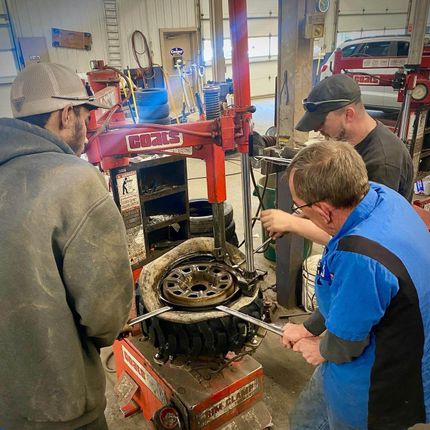Experience Precision with GMC Tire Service at Morris Tires
Wiki Article
Tire Service: The Effect of Climate Condition
When it involves ensuring ideal performance and safety and security when traveling, comprehending the influence of climate condition on tire solution is important. From scorching warmth to icy roadways, each climate element can significantly affect tire functionality and total driving experience. By delving right into the results of varying weather problems on tires, drivers can obtain important understandings that might improve their car's performance and long life. In this conversation, we will explore the detailed connection between weather and tire service, clarifying the importance of weather-specific tire upkeep methods and factors to consider.Heat and Tire Efficiency
When revealed to high temperatures, tires experience changes in performance that can dramatically affect lorry security and handling. The warm generated from long term driving or heat conditions causes the tire rubber to soften, causing lowered walk life and enhanced wear. As the rubber ends up being softer, the tire's grasp when driving diminishes, affecting braking distances and total grip. In extreme situations, too much warm can also cause tire blowouts, positioning an extreme security risk to the car and its residents.
Cold Weather Condition Effects
Cold weather problems can have a considerable influence on tire performance and safety and security. In chilly weather, tires may likewise shed air stress a lot more swiftly, which can impact dealing with and gas performance.To mitigate the results of winter on tires, it is important to frequently inspect tire pressure and inflate them to the producer's advised levels. Making use of winter or all-season tires created for cold climate problems can likewise improve traction and hold on icy or snowy roads. Correct tire upkeep, consisting of regular evaluations for wear and damage, comes to be a lot more critical throughout chillier months to make certain optimum efficiency and safety.
Rainy Conditions Influence
During stormy conditions, tire efficiency and safety and security can be dramatically influenced by the wet roadway surface areas and decreased presence. The tread pattern of tires plays a critical role in maintaining traction on wet roadways. Tires with damaged footsteps are extra susceptible to hydroplaning, where a layer of water develops between the tire and the road surface, leading to loss of traction. To fight this, drivers should routinely evaluate their tires for adequate tread deepness and think about spending in tires especially made for damp problems.Additionally, wet weather can additionally reduce presence, making it testing for drivers to see the road ahead clearly (GMC Tire Service). In such conditions, it is vital to change driving rates accordingly and keep a safe adhering to distance my response to permit unexpected stops. Effectively filled with air tires can also help in maintaining control on wet roads by offering better handling and grip
Snow and Tire Safety
Snow-covered roadways posture distinct difficulties for motorists, stressing the relevance of correct tire option and upkeep. When driving in snowy conditions, having the ideal tires can make a considerable difference in safety and security and efficiency. Wintertime tires are developed with special rubber compounds and step patterns to supply better traction on snow and ice contrasted to all-season tires. The deeper treads and sipes of winter tires aid hold the road better, decreasing the threat of sliding and gliding.
Moreover, motorists ought to take into consideration installing tire chains in extreme snowy problems. Tire chains supply additional traction by gripping the snow and ice, improving stability and control. It is essential to comply with producer guidelines when utilizing and installing tire chains to protect against damages to the tires and car (GMC Tire Service). By picking the ideal tires, preserving appropriate rising cost of living, and taking into consideration extra grip aids like tire chains, drivers can improve their safety when navigating snow-covered roadways.
Weather-Related Tire Maintenance
When confronted with numerous climate condition, proper tire maintenance comes to be an important aspect of lorry safety and security and efficiency. Weather-related tire maintenance includes a variety of techniques focused on making sure optimal tire function and durability in various climate circumstances. One key aspect of weather-related tire maintenance is tire stress policy. Varying temperature levels can create tire stress to vary, influencing traction and gas effectiveness. Regularly changing and examining tire pressure according to manufacturer helpful hints suggestions is important for secure driving in changing weather. In addition, tire step depth plays a considerable duty in managing different weather condition components. Tires with ample walk deepness provide better hold on damp or icy roadways, lowering the danger of skidding or hydroplaning. When walk wear reaches a certain depth is important for maintaining grip and security in adverse weather, checking tire step on a regular basis and changing tires. By prioritizing weather-related tire maintenance, drivers can boost safety and security, boost vehicle performance, and lengthen the life expectancy of their tires.
Verdict
In conclusion, climate conditions have a considerable effect on tire performance and safety. From heat affecting tire pressure and wear to cool climate lowering grip, it is crucial image source to take into consideration the weather when keeping and making use of tires.In this discussion, we will certainly discover the detailed relationship in between weather conditions and tire solution, losing light on the significance of weather-specific tire maintenance practices and factors to consider.

Report this wiki page